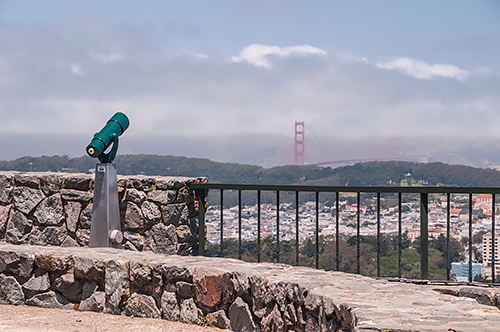Photo Corners headlinesarchivemikepasini.com
![]()
A S C R A P B O O K O F S O L U T I O N S F O R T H E P H O T O G R A P H E R
![]()
Enhancing the enjoyment of taking pictures with news that matters, features that entertain and images that delight. Published frequently.
The Overlook



15 July 2020
The sun came out yesterday so we grabbed our longest lens, dropped it into a holster and hiked up Twin Peaks. Forty-eight images later, we walked back down the hill.

The Overlook. Nikon D300 capture with 18-200mm Nikkor at 95mm (142.5mm equivalent) and f11, 1/60 second and ISO 200. Processed in Adobe Camera Raw.
We had quite an adventure we'll tell you about later. And we really enjoyed not just being outdoors with all our masked neighbors but shooting with the Nikon D300 and 18-200mm Nikkor.
Zoom lenses were not part of the kit when Eugène Delacroix sat down in Strasbourg on Sept. 1, 1859, to write this complaint about the new art of photography:
When a photographer takes a view, all you ever see is a part cut off from a whole: the edge of the picture is as interesting as the center; all you can do is to suppose an ensemble, of which you see only a portion, apparently chosen by chance. The accessory is capital, as much as the principal; most often, it presents itself first and offends the sight. One must make more concessions to the infirmity of the reproduction in a photographic work than in a work of the imagination. The photographs which strike you most are those in which the very imperfection of the process as a matter of absolute rendering leaves certain gaps, a certain repose for the eye which permit it to concentrate on only a small number of objects. If the eye had the perfection of a magnifying glass, photography would be unbearable: one would see every leaf on a tree, every tile on a roof, and on these tiles, mosses, insects, etc.
In the presence of nature herself, it is our imagination that makes the picture: we see neither the blades of grass in a landscape nor the accident of the skin in a pretty face. Our eye, in its fortunate inability to perceive these infinitesimal details, reports to our mind only the things which it ought to perceive; the later, again, unknown to ourselves, performs a special task; it does not take into account all that the eye presents to it; it connects the impressions it experiences with other which it received earlier, and its enjoyment is dependent on its disposition at the time. That is so true that the same view does not produce the same effect when taken in two different aspects.
With a zoom lens, the composition is rarely "chosen by chance." It's intentionally composed.
But his complaint about too much detail ("the perfection of a magnifying glass") rings true and is, perhaps, too often disregarded.
In the second paragraph, he hits the nail on the head when he argues "it is our imagination that makes the picture." But he's talking about the viewer filtering a scene either in the real world or before a canvas rendering of it. We filter the irrelevant out and focus on what matters.
Of our 48 images yesterday, we singled this one out today because it is unlike the others. It isn't about the details. Instead, it has a certain sadness about it.
The scope seems to be distracted from the beautiful bridge partly obscured by fog. It looks up aimlessly above the marine layer, lonely for the busloads of tourists that would stand around it, a few peeking through it to get closer to the surrounding landmarks.
In that sense it's not just a shot from yesterday but a portrait of our times.